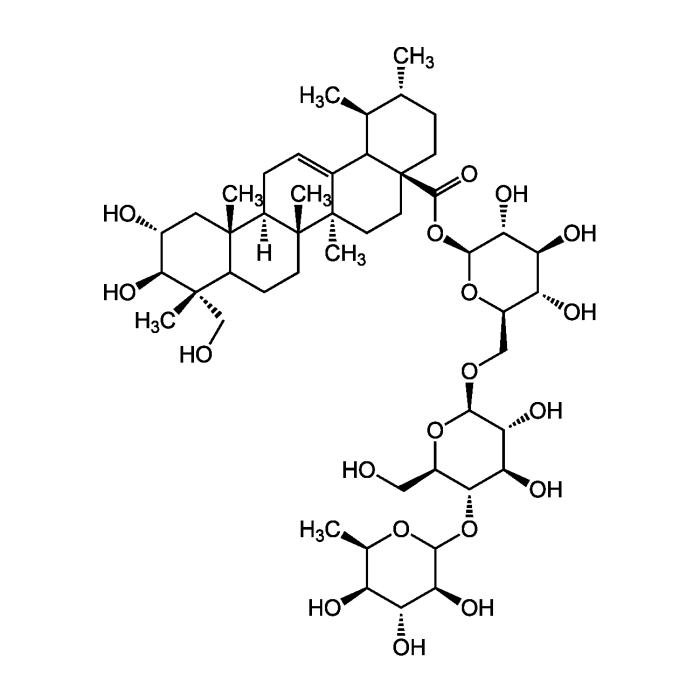Cookie Policy: This site uses cookies to improve your experience. You can find out more about our use of cookies in our Privacy Policy. By continuing to browse this site you agree to our use of cookies.
AdipoGen Life Sciences
Asiaticoside
As low as
80
CHF
CHF 80.00
In stock
Only %1 left
AG-CN2-0080-M01010 mgCHF 80.00
AG-CN2-0080-M05050 mgCHF 320.00

| Product Details | |
|---|---|
| Synonyms | Blastostimulina; Centelase; Emdecassol; Madecassol; Marticassol; FK1080; BRN 0078195; NSC 166062 |
| Product Type | Chemical |
| Properties | |
| Formula |
C48H78O19 |
| MW | 959.1 |
| CAS | 16830-15-2 |
| RTECS | YU9625000 |
| Source/Host Chemicals | Isolated from Centella asiatica. |
| Purity Chemicals | ≥95% (NMR) |
| Appearance | White solid. |
| Solubility | Soluble in ethanol, methanol or pyridine. Insoluble in water. |
| Identity | Determined by 1H-NMR and 13C-NMR. |
| InChi Key | WYQVAPGDARQUBT-NXDSUYQXBS |
| Smiles | [H][C@]12CC=C3C4[C@@H](C)[C@H](C)CC[C@@]4(CC[C@@]3(C)[C@]1(C)CCC1[C@](C)(CO)[C@@H](O)[C@H](O)C[C@]21C)C(=O)O[C@@H]1O[C@H](CO[C@@H]2O[C@H](CO)[C@@H](OC3O[C@H](C)[C@H](O)[C@@H](O)[C@@H]3O)[C@H](O)[C@H]2O)[C@@H](O)[C@H](O)[C@H]1O |
| Shipping and Handling | |
| Shipping | AMBIENT |
| Short Term Storage | +4°C |
| Long Term Storage | +4°C |
| Handling Advice | Keep cool and dry. |
| Use/Stability | Stable for at least 2 years after receipt when stored at +4°C. |
| Documents | |
| MSDS |
 Download PDF Download PDF |
| Product Specification Sheet | |
| Datasheet |
 Download PDF Download PDF |
Description
- Antibacterial.
- Human collagen I synthesis inducer. Anti-wrinkle activity.
- Shows wound healing activity. Enhances normal human skin cell migration, attachment and growth.
- Suppresses collagen expression and TGF-β/Smad signaling by inducing Smad7 and inhibiting TGF-βRI and TGF-βRII.
- Anti-inflammatory and antioxidant agent with anti-gastric ulcer activity.
- Mitogen-activated protein kinases (MAPKs), nuclear factor-κB (NF-κB), cyclooxygenase-2 (COX-2) and inducible nitric oxide synthase (iNOS; NOSII) expression, production of serum tumor necrosis factor (TNF-α) and interleukin-6 (IL-6) inhibitor.
- Anticancer agent. Shown to induce apoptosis and autophagy in cancer cells. Enhances antitumor activity of vincristine in cancer cells. Might be useful in cancer chemotherapy.
- Anxiolytic.
- Antidepressant-like activity.
- Hepatoprotective effects.
- CYP2C19 and CYP3A4 inhibitor.
- Neuroprotective.
- Antileishmanial activity.
- cPLA2 and sPLA2 inhibitor.
Product References
- In vitro and in vivo wound healing activity of asiaticoside isolated from Centella asiatica: A. Shukla, et al.; J. Ethnopharmacol. 65, 1 (1999)
- In vitro keratinocyte antiproliferant effect of Centella asiatica extract and triterpenoid saponins: J.H. Sampson, et al.; Phytomedicine 8, 230 (2001)
- The healing effects of Centella extract and asiaticoside on acetic acid induced gastric ulcers in rats: C.L. Cheng, et al.; Life Sci. 74, 2237 (2004)
- Inhibitory effects of Centella asiatica water extract and asiaticoside on inducible nitric oxide synthase during gastric ulcer healing in rats: J.S. Guo, et al.; Planta Med. 70, 1150 (2004)
- Improving lip wrinkles: lipstick-related image analysis: J.S. Ryu, et al.; Skin Res. Technol. 11, 157 (2005)
- Asiaticoside induces human collagen I synthesis through TGFbeta receptor I kinase (TbetaRI kinase)-independent Smad signaling: J. Lee, et al.; Planta Med. 72, 324 (2006)
- Anxiolytic-like effect of asiaticoside in mice: S.W. Chen, et al.; Pharmacol. Biochem. Behav. 85, 339 (2006)
- Effects of asiaticoside on the expression of Smad protein by normal skin fibroblasts and hypertrophic scar fibroblasts: S.H. Qi, et al.; Clin. Exp. Dermatol. 33, 171 (2008)
- Antidepressant-like effect of asiaticoside in mice: X. Liang, et al.; Pharmacol. Biochem. Behav. 89, 444 (2008)
- Protective effects of Asiaticoside on acute liver injury induced by lipopolysaccharide/D-galactosamine in mice: L. Zhang, et al.; Phytomedicine 17, 811 (2010)
- Asiaticoside suppresses collagen expression and TGF-β/Smad signaling through inducing Smad7 and inhibiting TGF-βRI and TGF-βRII in keloid fibroblasts: B. Tang, et al.; Arch. Dermatol. Res. 303, 563 (2011)
- In vitro inhibitory effects of asiaticoside and madecassoside on human cytochrome P450: T. Winitthana, et al.; Toxicol. In Vitro 25, 890 (2011)
- Asiaticoside: attenuation of neurotoxicity induced by MPTP in a rat model of Parkinsonism via maintaining redox balance and up-regulating the ratio of Bcl-2/Bax: C.L. Xu, et al.; Pharmacol. Biochem. Behav. 100, 413 (2012)
- Asiaticoside induces tumour-necrosis-factor-α-mediated nitric oxide production to cure experimental visceral leishmaniasis caused by antimony-susceptible and -resistant Leishmania donovani strains: S.K. Bhaumik, et al.; J. Antimicrob. Chemother. 67, 910 (2012)
- Inhibition of cPLA2 and sPLA2 activities in primary cultures of rat cortical neurons by Centella asiatica water extract: P.P. Defillipo, et al.; Nat. Prod. Commun. 7, 841 (2012)
- Asiaticoside enhances normal human skin cell migration, attachment and growth in vitro wound healing model: J.H. Lee, et al.; Phytomedicine 19, 1223 (2012)
- Antipyretic and Anti-inflammatory Effects of Asiaticoside in Lipopolysaccharide-treated Rat through Up-regulation of Heme Oxygenase-1: J. Wan, et al.; Phytother. Res. 27, 1136 (2013)
- Neuroprotective effects of Asiaticoside: F.Y. Qi, et al.; Neural. Regen. Res. 9, 1275 (2014)
- Asiaticoside attenuates the effects of spinal cord injury through antioxidant and anti‑inflammatory effects, and inhibition of the p38‑MAPK mechanism: Y. Luo, et al.; Mol. Med. Rep. 12, 8294 (2015)
- Burn wound healing properties of asiaticoside and madecassoside: Q. Hou, et al.; Exp. Ther. Med. 12, 1269 (2016)
- Effect of asiaticoside on endothelial cells in hypoxia‑induced pulmonary hypertension: X. Wang, et al.; Mol. Med. Rep. 17, 2893 (2018)
- Anti-inflammatory effect of asiaticoside on human umbilical vein endothelial cells induced by ox-LDL: L. Jing, et al.; Cytotechnology 70, 855 (2018)
- Antitumor Activity of Asiaticoside Against Multiple Myeloma Drug-Resistant Cancer Cells Is Mediated by Autophagy Induction, Activation of Effector Caspases, and Inhibition of Cell Migration, Invasion, and STAT-3 Signaling Pathway: L. Yingchun, et al.; Med. Sci. Monit. 25, 1355 (2019)






